How To Tell Snowball Bushes Apart: Is It A Snowball Viburnum Bush Or Hydrangea


The problem with using common plant names instead of the tongue-twisting Latin names that scientists assign them is that similar-looking plants often wind up with similar names. For instance, the name “snowball bush” can refer to a viburnum or a hydrangea. Find out the difference between viburnum and hydrangea snowball shrubs in this article.
Snowball Viburnum vs. Hydrangea
The old-fashioned snowball bush (Hydrangea arborescens), also called Anabelle hydrangea, produces large clusters of flowers that start out pale green and turn white as they mature. The Chinese snowball viburnum bush (Viburnum macrocephalum) is similar in appearance and also produces flowers that start pale green and age to white even though the two plants aren’t related. If you’re wondering how to tell snowball bushes apart, take a look at these characteristics:
- Snowball hydrangea shrubs grow 4 to 6 feet (1 to 2 m.) tall, while the viburnums grow 6 to 10 feet (2 to 3 m.) tall. If you’re looking at a shrub that is well over 6 feet (2 m.) tall, it is a viburnum.
- A snowball viburnum bush won’t tolerate a climate colder than U.S. Department of Agriculture plant hardiness zone 6. Snowball bushes growing in colder climates are probably hydrangeas.
- The hydrangeas have a much longer bloom period than the viburnums, with blossoms remaining on the shrub for as long as two months. Hydrangeas bloom in spring and may rebloom in fall, while viburnums bloom in summer.
- Hydrangeas have smaller flower heads that seldom exceed 8 inches (20.5 cm.) in diameter. Viburnum flower heads are 8 to 12 inches (20.5 to 30.5 cm.) across.
These two shrubs have similar requirements: they like light shade and moist but well-drained soil. Viburnum can tolerate drought in a pinch, but hydrangea is insistent about its moisture. The big difference is in the way the two shrubs are pruned. Cut hydrangeas back hard in late winter. This encourages them to come back lush and leafy in spring. Viburnums, on the other hand, need pruning right after the flowers fade. If you wait too long, you could lose next year’s beautiful flush of flowers.
Sign up for the Gardening Know How newsletter today and receive a free copy of our e-book "How to Grow Delicious Tomatoes".

Jackie Carroll has written over 500 articles for Gardening Know How on a wide range of topics.